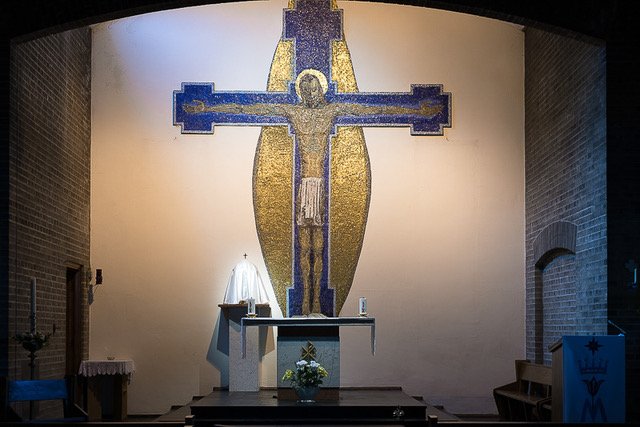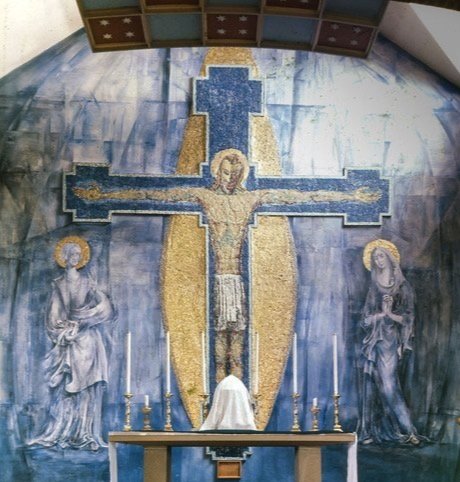George Mayer-Marton: Crucifixion mural


Title: Crucifixion mural
Artist: George Mayer-Marton (1897–1960)
Location: Church of the Holy Rosary, Oldham (RC)
Date: 1955
George Mayer-Marton’s Crucifixion mural at the Church of the Holy Rosary (1954–5) was one of several commissions by the Roman Catholic church in the North-West, but only one of three that survive. The mosaic depicts Christ on the cross in front of a golden mandorla, his head bowed. In the original mural he was flanked by Mary and John the Evangelist, in blue-toned fresco with golden mosaic haloes – the stylised rendering of Christ’s extended body and features, then, in contrast to the softer forms of the fresco painting with its flowing drapery: the new Christ, drawing together and transcending the styles and techniques of centuries of Christian image making. The use of Byzantine mosaic, in which glass and stone tesserae are set at differing depths and angles in the lime mortar, means that the work shimmers, Christ’s Passion made present in worship by the movements of light and of the congregation. The fresco, painted into the wet plaster, similarly insists on the material presence of the saints in the fabric of the modern church. The saints and the fresco background, a fractured sky, were painted over in 1980, leaving only the central mosaic, and can currently only be seen in photographs. A six-year campaign led by the artist’s great-nephew has demonstrated that the fresco is not, as previously feared, beyond saving, and it is hoped that they will be restored, and that the church, currently closed, will be returned to a role at the centre of Oldham’s Catholic community.
George Mayer-Marton (1897–1960) was born into a Jewish family in Győr, Hungary. After studying in Vienna and Munich he settled in Vienna where he played a central role in interwar artistic production and the development of Modernist styles. He fled to the UK in 1938, setting up a new studio in St John’s Wood, which, along with most of his early works in oil, was destroyed by bombing in 1940. In 1945 he discovered that his parents and brother, who had stayed in Hungary, had been killed in the Holocaust. From 1952 he taught at the Liverpool College of Art, pioneering instruction in mural and mosaic. He received a number of commissions from the Catholic Church to create murals and mosaics for postwar churches and schools. His works, mostly in oil and watercolour, are held in a number of UK museums and galleries, including the V & A, London, the Walker Art Gallery and the National Galleries of Scotland.
Further Information
Medium: Fresco and mosaic
Size: 7.5 x 5m
Permanent display
See Mayer-Marton’s Crucifixion mural on the Ecclesiart map here.
Other artworks in churches by George Mayer-Marton: Mosaic of St Clare of Assisi, St Clare’s, Blackley; mosaic of the Pentecost, now in Chapel of Unity, Liverpool Metropolitan Cathedral.
